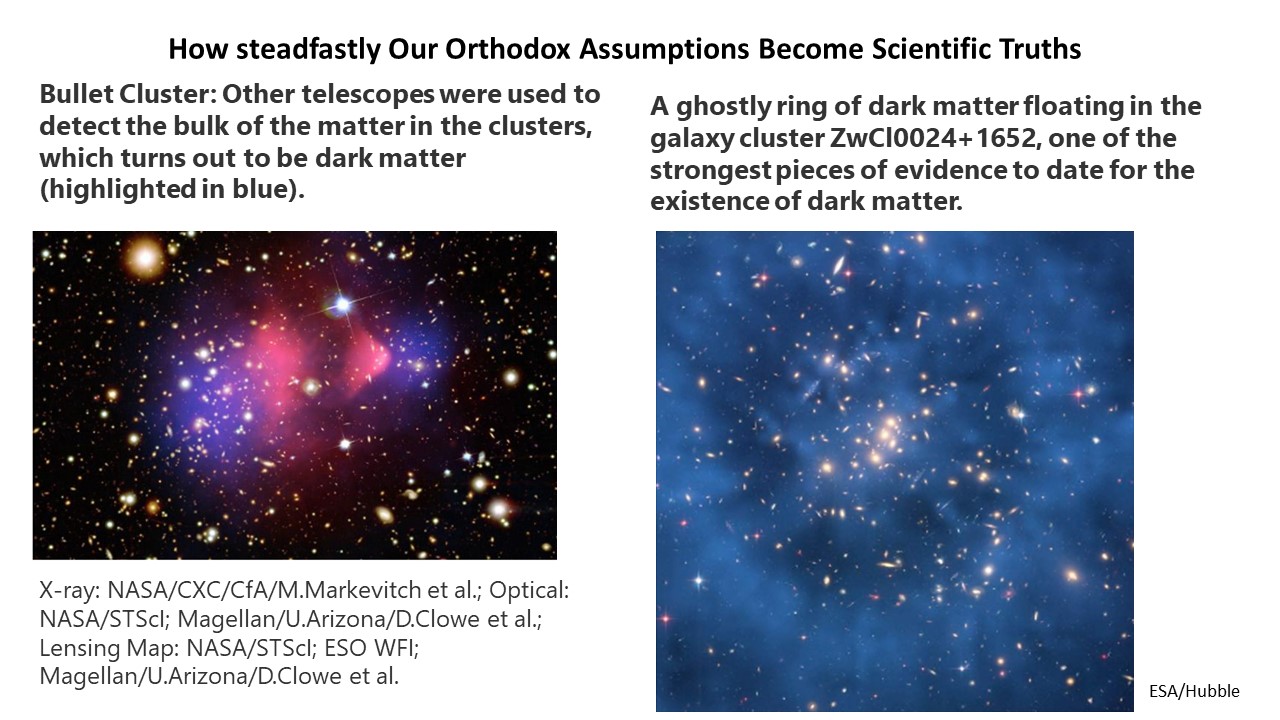After substantive “missing matter” reports some fifty years ago, scientists have spent decades in a quest for hidden particles. In the new millennium, alternative views suggest the search should be for new and/or unseen forces, not unknown matter.
With perceptions improving with more advanced technologies, what is the impact on current theories?
Mysteries we encounter too often seek solutions bound to a static frame of reference, our perception choosing only the fixed scene of the mystery, but nothing beyond. As a result, our theories centered on adding a “missing mass,” discovered by astronomer Fritz Zwicky in 1933, coining it dark matter (DM). The term stuck, though not taken seriously for decades.
Since the early 1970s, we have assumed that the presence of an unknown kind of invisible matter accounts for the excessive speed of visible matter in the galactic halo, and elsewhere. Based on seventeenth century scientific thinking, which was applied to planets in our own solar system, it guided the spectroscopic observations of stars and other objects on the fringes of galaxies.
Fifty years before, Edwin Hubble’s startling discovery of other galaxies in the 1920s — and then unexpectantly noting a stretching of space – had set the stage for the mystery of space’s expansion. It gave rise to expansion-of-the-universe theories that had adopted another unknown particle, Dark Energy (DE), this with repulsive force.
Orthodoxy says one does not convert into the other: for example, DE ≠ DMc2.
Still, investments in such theoretical pursuits not conclusively disproven, and based on current orthodoxy, have not run out. The focus is still on unseen or ghost particles, candidates often personalized, perhaps like the commercial world’s marketing strategies, generally heralding products as something “new” with a catchy name.
Capturing an anthropic presence are the names for current DM particle candidates. They turn out like character studies: male parts in a comic opera, WIMPS or MACHOs; no spin, axions; another dimension, Kaluza-Klein Particles; cuddly, Fuzzy DM; stand-offish, self-interacting DM; non-productive, Sterile Neutrinos; or cloaked, Dark Photons.
There might even be a dual personality – explaining both DE and DM — in the form of symmetrons, often called a little brother for the Higgs boson[i].
Our field of perception, however, is changing, becoming larger. Diffidently, one might ask, “Are 92 billion light-years across – and growing – large enough?” What else is beyond what we can now observe?
Theories are limited by current knowledge, expressed with what we know and what we can see. Up until about fifty years ago, we could not see what was in the intergalactic medium. It was not until this very year that the Sloan Digital Sky Survey (SDSS) released the largest, most-detailed 3D map of the cosmos, including 11 billion years of expansion history, greatly augmenting the scope of our view.
As our cosmic view expands, so do our models. Like a moving aerial video, we can begin to see the cosmic forest. We can start to understand in broad terms the immense moving parts of the Universe. In our own solar backyard alone, there are trillions of large masses, all seeming to be dragged by the Sun around the Milky Way’s galactic center on time scales of 100s of millions of years.
Until recently, our fixed vision has failed to consider the giant neighbor looming in our cosmic windshield. A monolithic, cohabitor of the Local Group, Andromeda, is moving toward us at about 109 kilometers per second. With the launch of SDSS-V, the next SDSS generation, more of Andromeda and giants beyond will come out of the shadows.
Fellow members of the Local Group and other outside galaxies and clusters are pulling on us as well, including more distant clumps of matter. The speed is some 300 km/s all in different directions proportional to their mass, distance, and gravitational pull.
If we could just hover above like the imagined DM phantoms, with heightened senses, we could not only see but feel, the lessened pressure of large regions of space with less matter, unseen virtual particles in and out tingling, all a presence between galaxies and galaxy clusters.
As we proceed light years, we could suddenly feel the heaviness of large regions of galactic space, pregnant with ample matter, swelling in a cosmic huddle.
As we soar, we can even see Andromeda, some 2.5 million light years away being photobombed by two massive black holes orbiting each other in a death spiral circling some 2 billion light years beyond.
Consuming light years of terrain, our senses detect mass, first over-dense and then, under-dense – in turns, oppressive, then vacuum.
If we zoom in closer, there are multiple tons of pressure at play, like the pounding of a gargantuan factory, but without the noise and the visible dynamics.
Perhaps the minion details are like miniature playground bodies, containing granules serving as packages of “rest” pulsating energy/mass that when activated with flashes of light produce energy released as electromagnetic (EM) radiation, pulsing and flaring.
In these intergalactic mediums, there are brilliant flares of energy produced by colliding protons and anti-protons. Rogue stars come into view within and between galaxies, stars flung out and abandoned, between galaxies and galaxy clusters. Thus, there’s fusion.
Space forums are varied and the mass – and its force — within them can defy calculation. Take black holes, for example. Supermassive black holes within galaxies and smaller sizes scattered within and without. Mass and spin can pose problems to general relativity (GR), including penetration of objects through the event horizon.
Another force, normally unsought beyond our local focus are electro-magnetic forces like the creation of a cosmic Frankenstein. Now technology makes detection easier with advanced tools like new low frequency radio telescopes. Even as I write this, the CSIRO radio telescope is mapping three million galaxies in just 300 hours, one million never seen before.
Just last year, astronomers examined a rather sparse region of space – the expanse between galaxy clusters. They found 10 million light-years of magnetized space, sending radiations of energy like networks of quivering arrows in all directions. There is no understanding of how it was formed.
Some suggest it could be an energy force that explains the expansion of the universe, thus speaking of discarding the simple explanation of a dark energy particle.
The Low-Frequency Array (LOFAR) radio telescope was used to observe vast ridges of radio-emitting plasma, galaxy clusters growing by a merging process producing shocks and turbulence in intracluster gas.
Contemporary knowledge is what feeds our theories and is input into our computer simulations. Our frame of reference evolving as observational tools improve and new studies are published.
There are curious worlds out there – moving in galaxies, galaxy-clusters and beyond. We are just beginning to witness them. What is known is that there is a living breathing dynamo-like cosmic presence, going through the cycles of birth, death, and rebirth in many ways, countenanced over light-year ranges in time and space.
In the last decade, spectral analysis of distant light, quasars, for example, allowed astronomers to study the circumgalactic medium containing gas 1000 times more dense than intergalactic gas. Such knowledge will become part of computer simulations, regarding movement and speed of galactic halos, for example.
Now simulations can begin to be depicted in accelerated frames of reference measuring outside interactions, including dense gas immediately surrounding galaxies. It is known that there are inflows of gas into galaxies and outflows – the former probably related to star-making and the latter thought to be supernovas blowing matter out.
GR theory, the curvature of spacetime often measures locally inert frames, but not globally non-inert. How much interacting mass in varied, assembled forms, emitting or absorbing energy, spread over a volume of space has an unpredicted global impact on the stars and gas circling light years around the outer edges of the Sagittarius core.
Perhaps looking at the teleparallel equivalent of general relativity could help visualize the long-range force determinants of gravity, maybe even light-year-range determinants when looking at cosmic gulps of matter. In other words, the torsion concept of teleparallel gravity might be helpful.
We know that undiscovered matter and connecting forces are not considered in many DM or DE models? Maybe there are really no ghost particles to explain excess gravity or an expanding universe, though that has been our “go-to” scenario for years. Maybe it’s just “ghost” forces pushing and bullying those fringe objects, or just-discovered or yet-to-be discovered matter/energy forces.
While the laws of motion are the same in all inertial frames, the impact of forces vary from frame to frame. For mass hurtling through the galactic halo, for example, the vector sum of the four forces – the net force — impacts the “hurtling objects,” from frame to frame, emanating from without and within the galaxy.
Even back in 1964, Irwin Shapiro spoke of gravitational wells and electromagnetic waves on galactic scales. More recently, Gregorio Baquero mentions “Density Waves” accumulating in “galactic and cosmic-scale structures, traveling energy quanta, composed of vacuum energy and gravitational waves, accompanied by neutrinos, electromagnetic waves, cosmic rays, stellar winds, waves and relativistic particles.[ii]”
We seemed to have overlooked the force of such energy and a possible role in not just perturbing Galactic halos but all neighborhoods of dark matter. A high concentration of traveling energy quanta can distort spacetime fabric in the same manner that mass would. Einstein’s theory of relativity taught us that energy can curve spacetime.
Consider the mass/energy sources surrounding, bifurcating, diverging, branching, and intermingling with these candidate areas for dark matter. How many interacting, latticing, and networking forces have we noticed and studied outside of internal frames of reference. What do we know about their galactic and intergalactic forces that tend to enhance mass and the forces that push mass apart?
More and more physicists are considering other approaches to this “excess gravity” problem that doesn’t include a “ghost particle.” Earlier this year, Alexandre Deur and associates said, “Calculations based on GR’s Lagrangian and parameter-free galactic models, we show the nonlinear effects of GR make baryonic matter alone sufficient to explain this observation.[iii]”
Deur cites GR’s self-interaction in large galactic masses between quarks and gluons in quantum chromodynamics and its binding and confinement of quarks and galactic correlations regarding acceleration as one consideration. He also cites sets of studies providing natural explanations for the expansion of the universe.
A few years ago, Gregorio Baquero wrote, “The higher concentration of travelling energy quanta around galaxies and galaxy clusters is creating extra gravitational distortion in spacetime with its mass equivalent.[iv]”
I do not pretend to understand the integral concepts arising from the mathematical modeling of sample environments, but I wonder how such samples can represent the vast and varied interrelationships that few seem capable of decoding and modelling. I tend to feel that the process and direction of the new studies pursued is right, keeping an open mind and incorporating new knowledge and concepts as they develop.
Perhaps you need supercomputers or even quantum computers to incorporate the dynamics of so many outside force variables.
Revolutionary finds are borne almost daily, found in multiple wave lengths – visible and invisible to our eyes. Just a few years ago, ripples in the fabric of space caused by two black holes colliding over a billion years ago ushered in a new means of discovery, gravitational waves.
Such discoveries will include forces integrally and relationally unseen before, perhaps revealing unknown quantum entanglements in the process, unlocking secrets forces never seen before.
[i] https://www.ill.eu/news-press-events/press-corner/press-releases/ill-studies-galectins-for-the- first-time-using-neutron-crystallography/
[ii]https://onedrive.live.com/?authkey=%21AH3nfZKfgWcDFWo&cid=4C5B741A4F65F0DC&id=4C5B741A4F65F0DC%2183311&parId=4C5B741A4F65F0DC%2173130&o=OneUp
[iii]https://iopscience.iop.org/article/10.3847/1538-4357/ab94b6
[iv] https://onedrive.live.com/?authkey=%21AH3nfZKfgWcDFWo&cid=4C5B741A4F65F0DC&id=4C5B741A4F65F0DC%2183311&parId=4C5B741A4F65F0DC%2173130&o=OneUp
Sources
https://www.scientificamerican.com/article/what-process-creates-and/, density waves
https://www.knowablemagazine.org/article/physical-world/2019/intergalactic-medium-gas-galaxy
https://en.wikipedia.org/wiki/Warm%E2%80%93hot_intergalactic_medium
https://en.wikipedia.org/wiki/Sloan_Digital_Sky_Survey
Our Growing Cosmic View and Dark Matter/Energy,



